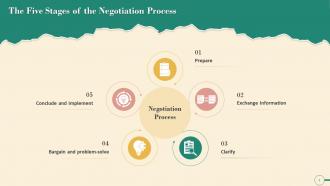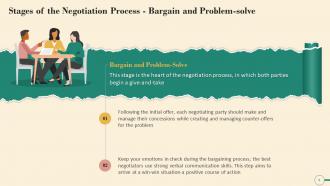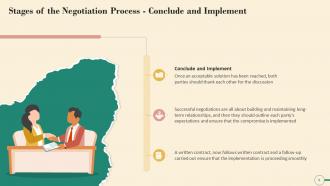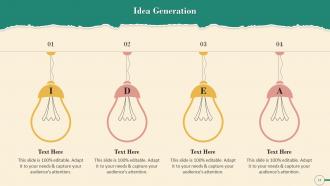Understanding Five Stages Of Negotiation Process Training Ppt
This set of slides illustrates the Five Stages of the Negotiation Process and their importance. The stages are Prepare, Exchange information, Clarify, Bargain and problem-solve, and Conclude and implement.
You must be logged in to download this presentation.
PowerPoint presentation slides
Presenting Understanding Five Stages of Negotiation Process. These slides are 100 percent made in PowerPoint and are compatible with all screen types and monitors. They also support Google Slides. Premium Customer Support available. Suitable for use by managers, employees, and organizations. These slides are easily customizable. You can edit the color, text, icon, and font size to suit your requirements.
People who downloaded this PowerPoint presentation also viewed the following :
Content of this Powerpoint Presentation
Slide 1
This slide illustrates the Five Stages of the Negotiation Process. The stages are: Prepare, Exchange Information, Clarify, Bargain and Problem-solve, and Conclude & Implement.
Instructor’s Notes:
Five Stages of Negotiation Process are:
- Prepare: Negotiation preparation is easy to overlook, but it is a crucial first step. To prepare, research both sides of the debate, identify any potential trade-offs, and determine your preferred and least preferred outcomes. Then, make a list of the concessions you're willing to make on the bargaining table, determine the relationship you want to build or maintain with the other party, and prepare your BATNA (“Best Alternative to a Negotiated Agreement"). Preparation can also include establishing ground rules, such as where, when, with whom, and under what time constraints the negotiations will occur
- Exchange Information: This is the negotiation stage in which both parties exchange their initial positions. Each side should be free to express their underlying interests and concerns, including what they hope to achieve at the end of the negotiation and why they feel the way they do
- Clarify: In this step, both parties continue the discussion while exchanging information to justify and support their claims. If one side disagrees with something the other side is saying, they should discuss it calmly to reach an understanding
- Bargain and problem-solve: This stage is the heart of the negotiation process, in which both parties begin a give-and-take. Following the initial offer, each negotiating party should make and manage their concessions while creating and managing counter-offers. Keep your emotions in check during the bargaining process; the best negotiators use strong verbal communication skills. This step aims to arrive at a win-win situation—a positive course of action
- Conclude and implement: Once an acceptable solution has been reached, both parties should thank each other for the discussion. Successful negotiations are all about building and maintaining long-term relationships, and then they should outline each party's expectations and ensure that the compromise is implemented. This step is frequently accompanied by a written contract and a follow-up to ensure that the implementation is proceeding smoothly
Slide 2
This slide explains the first stage of negotiation process that is Preparation. It mentions that negotiation preparation is easy to overlook, but it is a crucial first step. It also highlights that preparation also include establishing ground rules, such as where, when, with whom, and under what time constraints the negotiations will occur.
Slide 3
This slide explains the second stage of negotiation process which is exchanging information. It highlights that exchanging information is stage of negotiation in which both parties exchange their initial positions.
Slide 4
This slide describes the third stage of negotiation process that is clarification. It highlights that in this stage, both parties continue the discussion while exchanging information by justifying and supporting their claims. At this stage if one side disagrees with something the other side is saying, they should discuss it calmly to reach an understanding.
Slide 5
This slide explains the fourth stage of negotiation process that is Bargaining and Problem-Solving. It mentions that this stage is the heart of the negotiation process, in which both parties have to give-and-take. It also highlights that emotions must be in check during the bargaining process. Here, the best negotiators use strong verbal communication skills. This step aims to arrive at a win-win situation.
Slide 6
This slide depicts the fifth stage of negotiation process that is conclusion and implementation. In this stage, once an acceptable solution has been reached, both parties should thank each other. This stage is frequently accompanied by a written contract and a follow-up to ensure that the implementation proceeds smoothly.
Understanding Five Stages Of Negotiation Process Training Ppt with all 22 slides:
Use our Understanding Five Stages Of Negotiation Process Training Ppt to effectively help you save your valuable time. They are readymade to fit into any presentation structure.
-
Placing an order on SlideTeam is very simple and convenient, saves you a lot of your time.
-
They guys always go the extra mile to meet the expectations of their customers. Almost a year has been associated with them.



















































